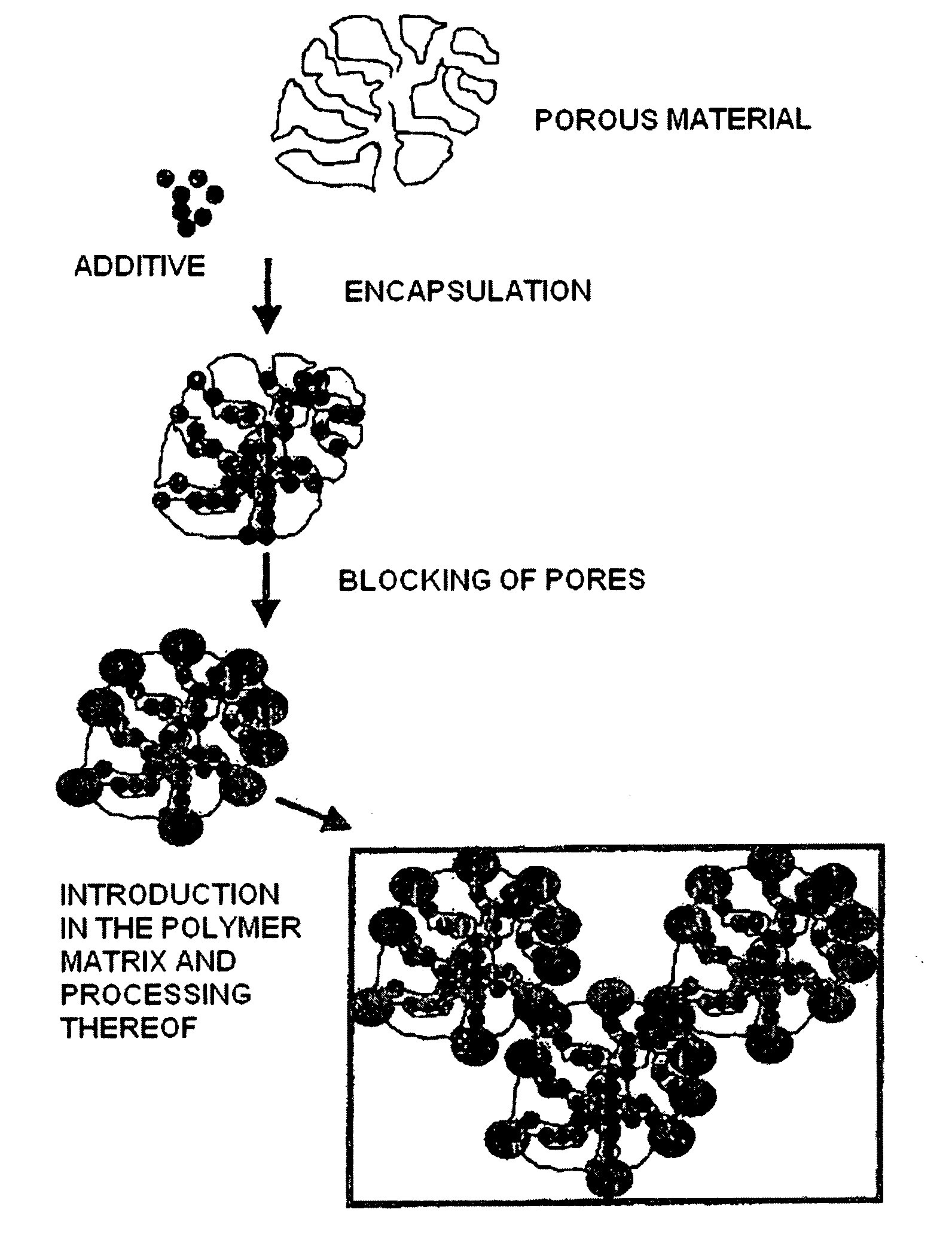Process for the additivation of synthetic fibres, artificial fibres and polymers with special properties
a technology of synthetic fibres and polymers, applied in the field of process for adding synthetic fibres, artificial fibres and polymers with special properties, can solve the problems of limiting the duration of their effect, unable to protect additives from the process conditions of the majority of polymer-based products, and difficult to obtain the pore capacity needed for highly efficient use on an industrial scal
- Summary
- Abstract
- Description
- Claims
- Application Information
AI Technical Summary
Benefits of technology
Problems solved by technology
Method used
Image
Examples
example 1
Additivation of Fibres of Polyamide 6 with Aloe-Vera
[0095]The aim of this additivation is to obtain multi-filament yarn of polyamide 6 for the lingerie market, containing aloe-vera. As aloe-vera is a natural product which would degrade under the processing conditions of the fibres, it needs to be encapsulated prior to being applied to the fibre.
[0096]Pure aloe-vera was used extracted from the plant Aloe barbadensis. Given the hydrophilicity of aloe-vera and its composition (4% of bulky molecules of the type sugars, anthraquinones, vitamins, etc.), a nanostructured mesoporous silica (SBA-15) of the following characteristics was chosen for its encapsulation: pore size 8.5 nm, BET area=920 m2 / g, particle size 0.5-1 μm.
[0097]The encapsulation process was carried out in the following way: 50 kg of SBA-15 were dehydrated by heating at a temperature of 250° C. for 8 h, afterwards the aloe-vera was mixed with the microparticles of SBA-15 for 24 hours, with continual stirring in order to pro...
example 2
Additivation of Polyethylene with a Thermochromic Additive for Plastics Applications
[0100]The aim of this microencapsulation is to obtain injected pieces of polyethylene containing a thermochromic additive which changes colour with temperature, for the manufacture of toys.
[0101]A thermochromic dye was used based on bis(diethylammonium) tetrachlorocuprate. Given the organophilicity of the additive a zeolite of the following characteristics was chosen for its encapsulation: pore size 0.7 nm, Si / Al ratio=infinity (organophilic), particle size 5-10 μm.
[0102]The encapsulation process was carried out in the following way: 50 kg of zeolite were dehydrated by heating at a temperature of 350° C. for 8 h, the dye was mixed with the microparticles of zeolite for 5 hours, with continual stirring in order to promote additive / capsule contact, and at room temperature. The additive / capsule proportion was 5 / 1. The post-treatments that were carried out were centrifugation of the sample with separatio...
PUM
| Property | Measurement | Unit |
|---|---|---|
| particle size | aaaaa | aaaaa |
| particle size | aaaaa | aaaaa |
| pore size | aaaaa | aaaaa |
Abstract
Description
Claims
Application Information
 Login to View More
Login to View More - R&D
- Intellectual Property
- Life Sciences
- Materials
- Tech Scout
- Unparalleled Data Quality
- Higher Quality Content
- 60% Fewer Hallucinations
Browse by: Latest US Patents, China's latest patents, Technical Efficacy Thesaurus, Application Domain, Technology Topic, Popular Technical Reports.
© 2025 PatSnap. All rights reserved.Legal|Privacy policy|Modern Slavery Act Transparency Statement|Sitemap|About US| Contact US: help@patsnap.com



